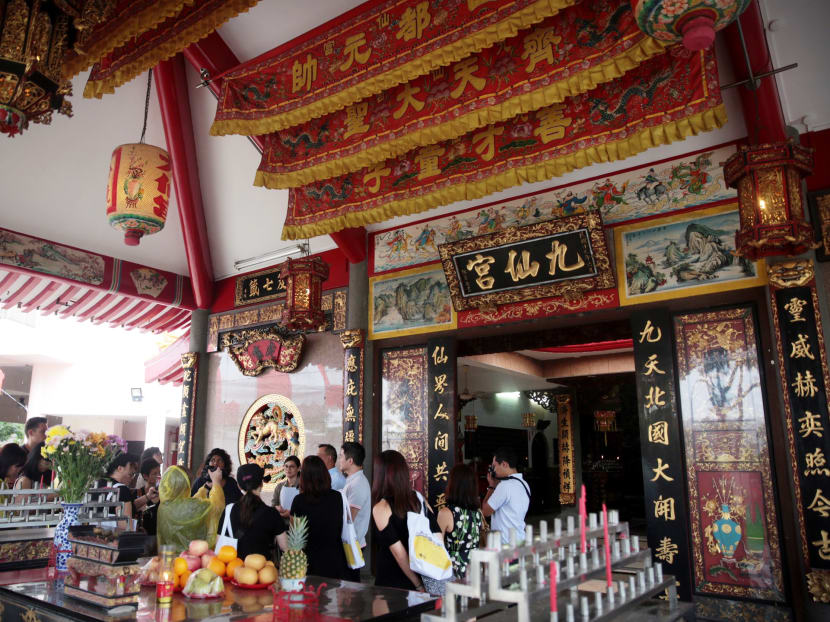NHB launches new Tampines Heritage Trail
SINGAPORE — The National Heritage Board’s (NHB) newest trail features green spaces, former kampong sites and a round market and food centre.

The Kew Sian King Temple, pictured here on Sept 6, is one of the landmarks of the Tampines Heritage Trail. Photo: Jason Quah
SINGAPORE — The National Heritage Board’s (NHB) newest trail features green spaces, former kampong sites and a round market and food centre.
The Tampines Heritage Trail includes the first cycling Green Spaces Trail, one of three short thematic routes spanning an average of 6km each.
The Green Spaces route allows visitors to discover places where former kampongs were once located, a temple cluster at Tampines Link and the Lorong Halus Wetland, which was a former landfill site.
The Lorong Halus Wetland, known for its sewage disposal centre and landfill facilities since the 1950s, is one of the more scenic spots on the Green Spaces Trail. When construction of the Serangoon Reservoir started in 2000s, a portion of the former landfill was converted into wetland to help treat potential contaminants in the groundwater.
Today, the wetland serves as a haven for biodiversity and leads to Pasir Ris Park, Punggol Promenade and Waterway, and Coney Island through integrated park connectors.
Mr Alvin Tan, the NHB’s assistant chief executive of policy and community, said: “The Green Spaces Trail is NHB’s first cycling trail which takes cyclists to heritage and nature sites within Tampines. This was curated for Tampines because of its well-integrated green spaces and because cycling is a way of life for many of its residents.”
The latest trail is the NHB’s 17th and draws attention to Tampines’ history as an exemplary model of public housing — making it the only town in Singapore to be conferred the World Habitat Award. Mr Tan also revealed that Tampines used to be “a hotbed of sand quarry operation”.
One of the former quarries is now Bedok Reservoir, while another is located along Tampines Avenue 10 and has remained untouched since the 1980s, filling with rainwater over time. It is sheltered from the main road by a thick line of trees.
The trail also shows visitors “a trace of Tampines’ kampong past in a row of shophouses on Hun Yeang Road” that used to be part of the Hun Yeang Village.
The shophouses along this road and Jalan Sam Kongsi Road are among the few physical reminders left of rural Tampines before the area underwent redevelopment in the late 1970s.
Perpendicular to Hun Yeang Road is Tampines Link where trail-goers can find the Temple Cluster.
Within it is the Kiew Sian King Temple, which has been in Tampines since the early 1900s. A stone tablet in this temple recounts aspects of its history including its founding by members of the Peh clan from Fujian province in China.
Another site on the trail is the Tampines Round Market and Food Centre, which has been a social hub for residents since its opening in 1983.
From first generation hawkers who opened stalls there 34 years ago, to residents living there since its kampong days, the stories of 25 members of the community have been included in the trail’s booklet.
Two other routes in the Tampines Heritage Trail are the Tampines Town Trail and the Religious Institutions Trail, both of which are bus-and-walk routes.
The Tampines Town Trail explores some of the town planning innovations in the estate and sites of everyday heritage that are part and parcel of life in the neighbourhood, such as the round market and food centre. This thematic route includes the Tampines Central Park with Housing Development Board’s iconic 1980s mangosteen and watermelon playgrounds.
The Religious Institutions Trail features various houses of faith that reflect the diversity of the Tampines community and explores their unique architecture and practices. The route includes the temple cluster as well as the majestic Tampines Chinese Temple at Tampines St 21, which has a 270m-long dragon sculpture along the temple’s perimeter.
Mr Tan added: “As with all our heritage trails, we hope Tampines heritage trail will increase public awareness of the heritage of Tampines and at the same time instill a sense of belonging amongst Tampines residents and maybe generate a sense of pride in being Singaporean because they will learn about Tampines progress as well as its achievements.”






